Parkside PABS 18-Li B2 User Manual [pl, cs, en, de]
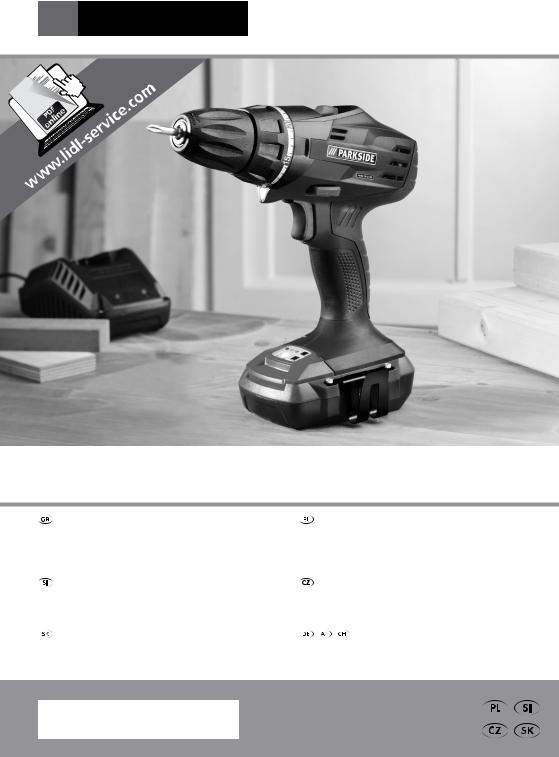
CORDLESS DRILL PABS 18-Li B2
CORDLESS DRILL |
WIERTARKO-WKRĘTARKA |
|||
Operation and Safety Notes |
AKUMULATOROWA |
|||
Translation of original operation manual |
Wskazówki |
dotyczące obsługi i bezpieczeństwa |
||
|
|
Tłumaczenie oryginalnej instrukcji obsługi |
||
AKUMOLATORSKI VRTALNI VIJAČNIK |
AKU VRTACÍ ŠROUBOVÁK |
|||
Navodila za upravljanje in varnostna opozorila |
Pokyny pro obsluhu a bezpečnostní pokyny |
|||
Prevod originalnega navodila za uporabo |
Překlad |
originálního provozního návodu |
||
AKU VŔTACÍ SKRUTKOVAČ |
AKKU-BOHRSCHRAUBER |
|||
Pokyny pre obsluhu a bezpečnostné pokyny |
Bedienungs - und Sicherheitshinweise |
|||
Preklad |
originálneho návodu na obsluhu |
Originalbetriebsanleitung |
||
IAN 75636

Before reading, unfold the page containing the illustrations and familiarise yourself with all functions of the device.
Przed przeczytaniem proszę rozłożyć stronę z ilustracjami, a następnie proszę zapoznać się z wszystkimi funkcjami urządzenia.
Pred branjem odprite stran s slikami in se nato seznanite z vsemi funkcijami naprave.
Před čtením si otevřete stranu s obrázky a potom se seznamte se všemi funkcemi přístroje.
Pred čítaním si odklopte stranu s obrázkami a potom sa oboznámte so všetkými funkciami prístroja.
Klappen Sie vor dem Lesen die Seite mit den Abbildungen aus und machen Sie sich anschließend mit allen Funktionen des Gerätes vertraut.
GB |
Operation and Safety Notes |
Page |
5 |
PL |
Wskazówki dotyczące obsługi i bezpieczeństwa |
Strona |
17 |
SI |
Navodila za upravljanje in varnostna opozorila |
Stran |
29 |
CZ |
Pokyny pro obsluhu a bezpečnostní pokyny |
Strana |
41 |
SK |
Pokyny pre obsluhu a bezpečnostné pokyny |
Strana |
51 |
DE / AT / CH |
Bedienungsund Sicherheitshinweise |
Seite |
61 |
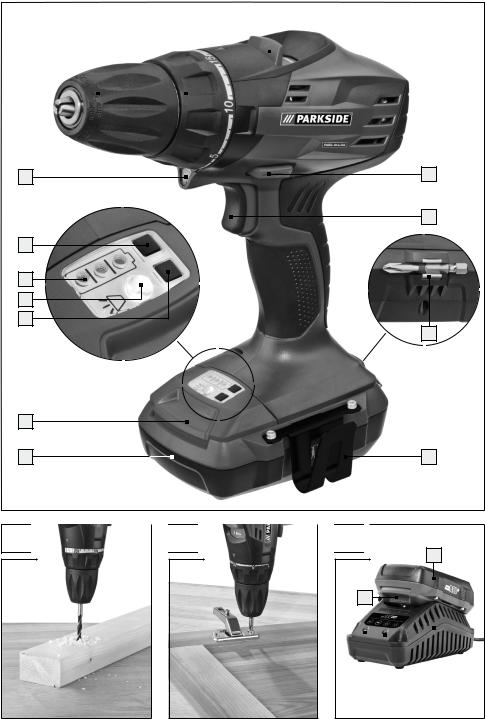
13 |
|
14 |
|
1 |
|||
|
|
|
|
|
|
|
|
|
|
|
|
|
|
|
|
12
11
10
9
8
7
6
A 

 B
B 

 C
C 

2
3
4
5
6
7
|
|
|
|
|
|
|
|
|
|
|
|
|
|
|
|
17 |
|
16 |
|
15 |
|||

Table of contents
Introduction |
|
|
Intended purpose................................................................................................................................. |
Page |
6 |
Equipment Components...................................................................................................................... |
Page |
6 |
Scope of delivery................................................................................................................................. |
Page |
7 |
Technical Data..................................................................................................................................... |
Page |
7 |
General safety advice for electrical power tools |
|
|
1. Workplace safety............................................................................................................................ |
Page |
8 |
2. Electrical safety............................................................................................................................... |
Page |
8 |
3. Personal safety................................................................................................................................ |
Page |
8 |
4. Careful handling and use of electrical power tools...................................................................... |
Page |
9 |
5. Use and handling of the cordless electrical power tool............................................................... |
Page |
9 |
6. Service............................................................................................................................................. |
Page 10 |
|
Safety advice relating to cordless drill drivers................................................................................... |
Page 10 |
|
Attention - Service lines!...................................................................................................................... |
Page 10 |
|
Original ancillaries / accessories........................................................................................................ |
Page 10 |
|
Before first use |
|
|
Charging the battery pack.................................................................................................................. |
Page 10 |
|
Insertion / removal of a battery pack into the appliance.................................................................. |
Page 11 |
|
Checking battery status....................................................................................................................... |
Page 11 |
|
Changing tools.................................................................................................................................... |
Page 11 |
|
Torque pre-selection............................................................................................................................ |
Page 11 |
|
2 Gear Drive........................................................................................................................................ |
Page 12 |
|
Preparing the tool for use |
|
|
Switching On / Off............................................................................................................................... |
Page 12 |
|
Switching the LED light on and off...................................................................................................... |
Page 12 |
|
Adjusting the speed............................................................................................................................. |
Page 12 |
|
Switching direction of rotation............................................................................................................ |
Page 12 |
|
Tips and Tricks...................................................................................................................................... |
Page 12 |
|
Cleaning and Maintenance............................................................................................... |
Page 13 |
|
Service................................................................................................................................................ |
Page 13 |
|
Warranty......................................................................................................................................... |
Page 13 |
|
Disposal............................................................................................................................................. |
Page 14 |
|
Conformity Declaration / Manufacturer................................................................. |
Page 15 |
|
GB 5
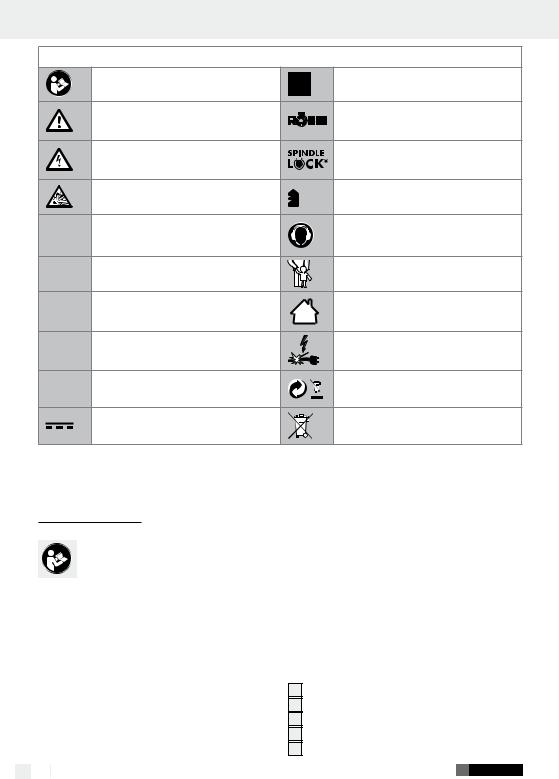
Introduction
The following pictograms are used in these operating instructions / on the device:
|
Read instruction manual! |
Safety class II |
|
|
Observe caution and safety notes! |
Drill chuck, Made In Germany |
|
|
Caution – electric shock! |
Spindle lock |
|
|
Danger to life! |
||
|
|
||
|
Explosive material! |
Drill setting (torque preselect) |
|
W |
Watts (Effective power) |
Wear ear protection. |
|
|
|||
n0 |
Design no-load speed |
Keep children away from electrical |
|
power tools! |
|||
|
|||
V~ |
Voltage |
For indoor use only! |
|
Ah |
Amp (Battery capacity) |
Check that the device, mains lead |
|
and plug are in good condition! |
|||
Nm |
Newton metre (torque) |
Dispose packaging and appliance in |
|
an environmentally-friendly way! |
|||
|
|
||
|
DC (current and voltage type) |
Do not dispose of rechargeable |
|
|
batteries with your household refuse! |
||
|
|
Cordless drill PABS 18-Li B2
Q Introduction
We congratulate you on the purchase of your new device. You have chosen a high
quality product. The instructions for use are part of the product. They contain important information concerning safety, use and disposal. Before using the product, please familiarise yourself with all of the safety information and instructions for use. Only use the unit as described and for the specified applications. If you pass the product on to anyone else, please ensure that you also pass on all the documentation with it.
6 GB
Q Intended purpose
This appliance is designed for drilling and screwing into wood, plastic and metal. Use the appliance only as described and only for the purposes indicated.
Any other uses, and modifications to the appliance, are deemed to be improper usage and may result in serious physical injury. The manufacturer accepts no responsibility for damage(s) resulting from improper usage. The appliance is not intended for commercial use.
Q Equipment Components
1Gear selector switch
2Direction of rotation switch / lock
3ON / OFF Switch / R.P.M. regulator
4Bit holder
5Belt clip

Introduction / General safety advice for electrical power tools
6Rechargeable battery pack
7Battery pack release button
8LED light button
9LED light
10Rechargeable battery display LED
11Rechargeable battery charge state button
12LED working light
13Drill chuck 


14Torque pre-selector
15Fast charger
16Red charge-control LED
17Green charge-control LED
Q Scope of delivery
1 Cordless drill with rechargeable battery pack
1 Bit PH2 50 mm
1 Fast charger
1 Carry case
1 Directions for use
Q Technical Data
PABS 18-Li B2 Cordless drill:
Nominal voltage: |
18 V |
|
|
|
|||
Idle-running speed: |
1st gear: max. 400 min-1 |
||
Idle-running speed: |
2nd gear: max. 1400 min-1 |
||
Drill chuck |
|
|
|
clamping range: |
max. 10 mm |
||
Maximum |
|
|
|
drill diameter: |
Steel: 10 mm, |
||
|
Wood: 30 mm |
||
Max. torque: |
35 Nm |
||
PABS 18-Li B2-1 Battery Pack: |
|||
Type: |
LITHIUM-ION |
||
Nominal voltage: |
18 V |
|
|
|
|||
Capacity: |
1.5 Ah |
||
Energy content: |
27 Wh |
||
PABS 18-Li B2-2 Fast Charger: |
|||
INPUT |
|
|
|
Nominal voltage: |
230 V , 50 Hz |
||
Power input: |
55 W |
||
OUTPUT |
|
|
|
Nominal voltage: |
18 V |
|
|
|
|||
Charging current |
2 A |
||
Charging time: |
approx. 60 min |
||
Protection class: |
II / |
||
Noise and vibration data:
Measured values for noise are determined in accordance with EN 60745. The A-weighted noise level of the electrical power tool are typically:
Sound pressure level: |
76 dB(A) |
Sound power level: |
87 dB(A) |
Uncertainty K: |
3 dB |
Total vibration (vector sum of three directions) is calculated in accordance with EN 60745:
Screwing: |
Vibration emission value |
|
ah,D = 0.865 m / s2, |
|
uncertainty K = 1.5 m / s2, |
Drilling: |
Vibration emission value |
|
ah = 2.546 m / s2, |
|
uncertainty K = 1.5 m / s2. |

 The vibration level specified in these instructions was measured in accordance with an EN 60745 standardised measurement process and can be used to compare equipment. The vibration emission value specified can also serve as a preliminary assessment of the exposure.
The vibration level specified in these instructions was measured in accordance with an EN 60745 standardised measurement process and can be used to compare equipment. The vibration emission value specified can also serve as a preliminary assessment of the exposure.
The vibration level will change according to the application of the electrical tool an in some cases may exceed the value specified in these instructions. Regularly using the electric tool in such a way may make it easy to underestimate the vibration.
Note: If you wish to make an accurate assessment of the vibration loads experienced during a particular period of working, you should also take into account the intervening periods of time when the device is switched off or is running but is not actually in use. This can result in a much lower vibration load over the whole of the period of working.
GB 7
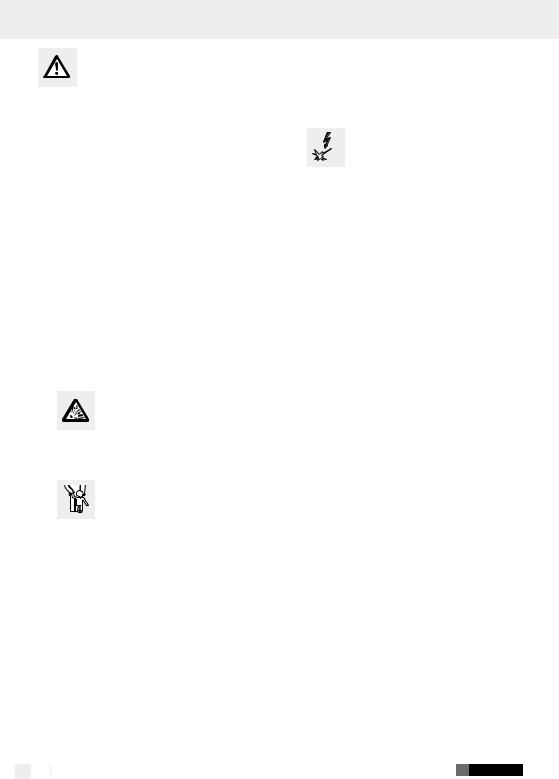
General safety advice for electrical power tools
General safety advice for electrical power tools

 Read all the safety advice and instructions! Failure to observe the safety advice and instructions may result in electric shock, fire and / or serious injury.
Read all the safety advice and instructions! Failure to observe the safety advice and instructions may result in electric shock, fire and / or serious injury.
Keep all the safety advice and instructions in a safe place for future reference!
The term “electrical tool” used in the safety advice refers to electrical tools powered by mains electricity (by means of a mains lead) and electrical tools powered by rechargeable batteries (without a mains lead).
1. Workplace safety
a)Keep your working area clean and well lit. Untidy or poorly lit working areas can lead to accidents.
b)Do not work with the device
in potentially explosive environments in which there are
inflammable liquids, gases or dusts.
Electrical power tools create sparks, which can ignite dusts or fumes.
c)Keep children and other
people away while you are operating the electrical tool.
Distractions can cause you to lose control of the device.
2. Electrical safety
a)The mains plug on the device must match the mains socket. The plug must not be modified in any way. Do not use an adapter plug with devices fitted with a protective earth. Unmodified plugs and matching sockets reduce the risk of electric shock.
b)Avoid touching earthed surfaces such as pipes, radiators, ovens and refrigerators with any part of your body.
8 GB
There is an increased risk of electric shock if your body is earthed.
c)Keep the device away from rain or moisture. Water entering an electrical device increases the risk of electric shock.
d)Do not use the mains lead for
any purpose for which it was 
 not intended, e.g. to carry the device, to hang up the device or to pull the mains plug out of the mains socket. Keep the mains lead away from heat, oil, sharp edges or moving parts of the device. Damaged or tangled mains leads increase the risk of electric shock.
not intended, e.g. to carry the device, to hang up the device or to pull the mains plug out of the mains socket. Keep the mains lead away from heat, oil, sharp edges or moving parts of the device. Damaged or tangled mains leads increase the risk of electric shock.
e)When working outdoors with an electrical power tool always use extension cables that are also approved for use outdoors. The use of an extension cable suitable for outdoor use reduces the risk of electric shock.
f)Use a residual current device (RCD) for protection if operating the electrical power tool in a moist environment is unavoidable. The use of an RCD reduces the risk of electric shock.
3.Personal safety
a)Remain alert at all times, watch what you are doing and always proceed with caution. Do not use the device if you are tired or under the influence of drugs, alcohol or medication. One moment of carelessness when using the device can lead to serious injury.
b)Wear personal protective equipment and always wear safety glasses. The wearing of personal protective equipment such as dust masks, non-slip safety shoes, safety helmets or ear protectors, appropriate to the type of electrical power tool used and work undertaken, reduces the risk of injury.
c)Avoid unintentional operation of the device. Check that the electrical power tool is switched off before you connect it to the mains, pick it up or carry it.
Accidents can happen if you carry the device

General safety advice for electrical power tools
with your finger on the ON / OFF switch or with the device switched on.
d)Remove any setting tools or spanners before you switch the device on. A tool or spanner left attached to a rotating part of a device can lead to injury.
e)Avoid placing your body in an unnatural position. Keep proper footing and balance at all times. By doing this you will be in a better position to control the device in unforeseen circumstances.
f)Wear suitable clothing. Do not wear loose clothing or jewellery. Keep your hair, clothing and gloves clear of moving parts. Loose clothing, jewellery or long hair can become trapped in moving parts.
g)If vacuum dust extraction and collection devices are fitted do not forget to check that they are properly connected and correctly used. The use of these devices reduces the hazard presented by dust.
4.Careful handling and use of electrical power tools
a)Do not overload the device. Always use an electrical power tool that is intended for the task you are undertaking. By using the right electrical power tool for the job you will work more safely and achieve a better result.
b)Do not use an electrical power tool if its switch is defective. An electrical power tool that can no longer be switched on and off is dangerous and must be repaired.
c)Pull the mains plug out of the socket and / or remove the rechargeable battery before you make any adjustments to the device, change accessories or when the device is put away. This precaution is intended to prevent the device from unintentionally starting.
d)When not in use always ensure that electrical power tools are kept out of reach of children. Do not let anyone use the device if he or she is not familiar with it or has not read the instructions
and advice. Electrical power tools are dangerous when they are used by inexperienced people.
e)Look after the device carefully. Check that moving parts are working properly and move freely. Check for any parts that are broken or damaged enough to detrimentally affect the functioning of the device. Have damaged parts repaired before you use the device. Many accidents have their origins in poorly maintained electrical power tools.
f)Keep cutting tools clean and sharp.
Carefully maintained cutting tools with sharp cutting edges are less likely to jam and are easier to control.
g)Use the electrical power tool, accessories, inserted tools etc. in accordance with these instructions and advice, and the stipulations drawn up for this particular type of device. In doing this, take into account the working conditions and the task in hand. The use of electrical power tools for purposes other than those intended can lead to dangerous situations.
5.Use and handling of the cordless electrical power tool
a)Charge a rechargeable battery unit using only the charger recommended by the manufacturer. Chargers are often designed for a particular type of rechargeable battery unit. There is the danger of fire if other types of rechargeable battery units are used.
b)Only the rechargeable battery units supplied are to be used with an electrical power tool. The use of other rechargeable battery units may lead to the danger of injury or fire.
c)When they are not being used, store rechargeable battery units away from paperclips, coins, keys. nails, screws or other small metal objects that could cause the contacts to be bridged. Shortcircuiting the contacts of a rechargeable battery unit may result in heat damage or fire.
GB 9

General safety advice for electrical power tools / Before first use
d)Fluids may leak out of rechargeable battery units if they are misused. If this happens, avoid contact with the fluid. If contact occurs, flush the affected area with water. Seek additional medical help if any of the fluid gets into your eyes. Escaping battery fluid may cause skin irritation or burns.
CAUTION! DANGER OF EXPLOSION! The batteries must never be recharged!
6. Service
a)Have your device repaired at the service centre or by qualified specialist personnel using original manufacturer parts only. This will ensure that your device remains safe to use.
Safety advice relating to cordless drill drivers

 Hold the device by the insulated handle surfaces when you are undertaking work where there is the danger of the screw striking hidden electricity cables or the device’s mains lead. Contact of the screw with a live wire could cause metal parts of the device to become live and lead to electric shock.
Hold the device by the insulated handle surfaces when you are undertaking work where there is the danger of the screw striking hidden electricity cables or the device’s mains lead. Contact of the screw with a live wire could cause metal parts of the device to become live and lead to electric shock.
Children or persons who lack the knowledge or experience to use the device or whose physical, sensory or intellectual capacities are limited must never be allowed to use the device without supervision or instruction by a person responsible for their safety. Children must never be allowed to play with the device.
Securely support the workpiece. A workpiece held in a clamp or vice is kept more securely in place than one held by your hand.

 POISONOUS DUSTS!
POISONOUS DUSTS!
Harmful / noxious dusts generated from your work represent a risk to the health of the person operating the device and to anyone near the work area. Wear safety glasses and a dust mask!
10 GB
Do not drill any material containing asbestos. Asbestos is a known carcinogen.
Hold the electrical power tool firmly.
High reaction torques may occur momentarily during tightening or loosening of screws.
If the inserted tool jams, switch off the electrical power tool immediately. Be prepared for high reaction torques as they may cause kickback. The inserted tool may jam if the electrical power tool is overloaded or is held at an angle to the workpiece.
Before you carry out any tasks on the device, transport or store it, make sure that the direction of rotation switch is in the middle position (lock). To prevent the device from starting up unintentionally.
Q Attention - Service lines!
 Danger! Take steps to ensure that you do not hit upon any service lines (electricity, gas, water) when working with electrical appliances. Check, if need be with a service line detector, before you start to cut or bore into a surface.
Danger! Take steps to ensure that you do not hit upon any service lines (electricity, gas, water) when working with electrical appliances. Check, if need be with a service line detector, before you start to cut or bore into a surface.
QOriginal ancillaries/ accessories
Use only the ancillaries and accessories that are detailed in the operating instructions. The use of ancillaries and accessories other than those recommended in the operating instructions could lead to an increased risk of personal injury for you.
QBefore first use
QCharging the battery pack

 DANGER OF ELECTRIC SHOCK! Before cleaning or servicing the charging station or the battery pack always ensure that the plug is not in the mains socket.
DANGER OF ELECTRIC SHOCK! Before cleaning or servicing the charging station or the battery pack always ensure that the plug is not in the mains socket.

Note! A new battery pack, or one that has not been in use for an extended period, must be charged up before the first / renewed usage.
The battery pack attains its full capacity after ca. 3–5 charging cycles.
 CAUTION! Always ensure the plug is removed from the mains socket before inserting a battery pack into, or removing one from, the charging station.
CAUTION! Always ensure the plug is removed from the mains socket before inserting a battery pack into, or removing one from, the charging station.
Never charge the battery pack if the ambient temperature is less than 10 °C or greater than 40 °C.
1.Insert the battery pack 6 into the quickcharger 15 (see Fig. C).
2.Insert the mains plug into the mains socket. The flashing green charge indicator LED 17 shows that charging is in progress.
3.The charging process is completed when the green charge indicator LED 17 light up and the accumulator pack 6 is ready for operation.
4.If the red charge indicator LED 16 lights up, the quick battery charger 15 is in standby mode; the accumulator pack 6 is not connected.
5.If the red charge indicator LED 16 starts flashing, this means that the accumulator pack 6 has become too hot; no charging process.
Never charge the battery pack for a second time immediately after a fast charging process has been completed. This can give rise to the battery pack becoming overcharged and to a reduced service life of the battery and charging station. Switch the charger off for at least 15 minutes between two successive charging procedures. Remove the power plug from the wall socket.
Before first use
Inserting the rechargeable battery pack:
Move the rotation switch 2 into the middle position (lock) and push the rechargeable battery pack 6 into the handle until it engages.
Removing the rechargeable battery pack:
Press the release button 7 and remove the rechargeable battery pack
Q Checking battery status
To check the battery status, press the battery LED button 11 (refer to main diagram). The status or residual capacity will be indicated in the battery LED 10 as follows: GREEN / RED / ORANGE = maximum charge / capacity
RED / ORANGE = medium charge / capacity RED = weak charge – recharge battery
Q Changing tools
Your cordless electric drill / screwdriver has a fully automatic spindle lock 


 and is fitted with an enclosed keyless chuck incorporating the latest technology from
and is fitted with an enclosed keyless chuck incorporating the latest technology from 

 ”Made in Germany”.
”Made in Germany”.
Once the motor has come to a halt, the drive shaft is automatically locked, so that the chuck 13 can be opened simply by turning it .
.
After you have inserted the required bit and fixed it in place by turning the chuck  , you can immediately continue working. The spindle lock releases itself automatically when the motor is started (by operation of the ON / OFF switch 3 ).
, you can immediately continue working. The spindle lock releases itself automatically when the motor is started (by operation of the ON / OFF switch 3 ).
QInsertion / removal of a battery pack into the appliance
Ensure that the appliance is switched off before inserting the battery. The insertion of a battery into an electrical appliance that is switched on can lead to accidents.
Q Torque pre-selection
You can adjust the torque by using 14 torque preselection. The torque levels regulate a range of up to ca. 35 Nm.
Select a low setting for small screws, soft work material.
GB 11

Before first use / Preparing the tool for use
Select a high setting for large screws, hard work materials and for the extraction of screws. For drilling, push the selector to the setting for drilling, in that you adjust the torque pre-selector to the position  .
.
For drilling tasks, also push the gear selector switch 1 to the front (Position: 2).
Q 2 Gear Drive
 CAUTION! Move the gear selector switch 1 only after the device has come to a standstill. Failure to observe this advice may result in damage to the device.
CAUTION! Move the gear selector switch 1 only after the device has come to a standstill. Failure to observe this advice may result in damage to the device.
In the first gear (Gear selector switch 1 in Position: 1)
A speed of up to approx. 400 rpm can be achieved and a high torque. This setting is intended for use with all screwing tasks and for accessories (see example Fig. B).
In the second gear (Gear selector switch 1 in Position: 2)
It achieves a speed of up to approx. 1400 rpm, for the carrying out of drilling tasks (see example Fig. A).
Switching the LED light on and off
Switching on:
Press the LED light button 8 to switch on the LED light 9 .
Switching off:
Press the LED light button 8 again to switch off the LED light 9 .
Q Adjusting the speed
The ON / OFF switch 3 has a variable speed control device. Slight pressure on the ON / OFF switch 3 will cause the rotation speed to slow down. With increased pressure, the rotational speed will increase.
Note: The integrated engine brake means that the device will come to a fast standstill.
Q Switching direction of rotation
To switch the direction of rotation, push the direction of rotation switch 2 to either the right or to the left.
QPreparing the tool for use
QSwitching On /Off
Switching on:
To start the appliance squeeze on the ON / OFF switch 3 and then keep it pressed down. The LED working light 12 comes on with a slightly or fully pressed ON /OFF switch 3 and illuminates the working area in poor lighting conditions.
Switching off:
To stop the appliance, release the ON / OFF switch 3 .
12 GB
Q Tips and Tricks
Before you use the appliance, check to see that the screw or drill bit is properly fitted, i.e. located centrally in the chuck.
Screw bits are designated with their dimensions and their shape. If you are unsure, always try the particular screw bit out to see whether it sits in the screw head without any free play.
Torque:
Smaller screws and bits in particular can be easily damaged if you adjust the appliance with too high a torque and/or rotation speed.
Hard screwdriving conditions (into metal):
Particularly high torques can occur, for example with metal screws tightened by socket tool bits. Select a lower rotation speed.

Preparing the tool for use / Cleaning and Maintenance / Service / Warranty
Soft screwdriving conditions (e.g. into soft wood):
You should also select a low speed in order not to damage the wood workpiece surface through contact with the metal screw head. Use a countersinker.
When drilling into wood, metal and other materials, take note of the following advice:
With small diameter drill bits use a high drill speed. For large diameter drill bits, use a low drill speed.
For hard materials, select a low drill speed. For soft materials, select a high drill speed.
Secure or fix down the workpiece (if possible) in a clamp or vice.
Mark the intended position of the hole with a centre punch or a nail and select a low drill speed for drilling.
Take the rotating drill bit out of the hole frequently so that swarf or drill dust can be re-moved and the hole and tool is ventilated.
Drilling in metal:
Use a metal drill bit (HSS). For the best results, you should cool the bit with oil. Metal drill bits can also be used to drill into plastic.
Drilling in stone:
Use a circular shafted masonry drill bit with a hardened metal tip.
Drilling in wood:
Normally you should use a wood drill with a centring point. For deep holes, use an auger type bit. For large diameter holes, use a forstner bit. You can screw small screws into soft wood without the need for pre-drilling.
Q Cleaning and Maintenance
 CAUTION! Place the direction of rotation switch 2 into the middle position before carrying out any tasks on the device, e.g. changing tools or maintenance, or before transporting or storing the device. Inadvertent operation of the ON / OFF switch 3 may result in injury.
CAUTION! Place the direction of rotation switch 2 into the middle position before carrying out any tasks on the device, e.g. changing tools or maintenance, or before transporting or storing the device. Inadvertent operation of the ON / OFF switch 3 may result in injury.
Pull the mains lead out of the mains socket every time and remove the battery before you clean or maintain the device.
The Cordless drill is maintenance-free.
Always keep the device clean, dry and free of oil or grease.
Clean the device immediately after you have finished using it.
Do not allow any liquids to enter the device. Use a cloth to clean the housing. Never use petrol, solvents or cleaning agents that might attack plastic.
Q Service

 Have your device repaired at the service centre or by qualified specialist personnel using original manufacturer parts only. This will ensure that your device remains safe to use.
Have your device repaired at the service centre or by qualified specialist personnel using original manufacturer parts only. This will ensure that your device remains safe to use.

 If the plug or lead needs to be replaced, always have the replacement carried out by the manufacturer or its service centre. This will ensure that your device remains safe to use.
If the plug or lead needs to be replaced, always have the replacement carried out by the manufacturer or its service centre. This will ensure that your device remains safe to use.
Q Warranty
The warranty for this appliance is for 3 years from the date of purchase. The appliance has been manufactured with care and meticulously examined before delivery. Please retain your receipt as proof of purchase. In the event of a warranty claim, please make contact by telephone with our Service Department. Only in this way can a post-free despatch for your goods be assured.
The warranty covers only claims for material and maufacturing defects, but not for transport damage, for wearing parts or for damage to fragile components, e.g. buttons or batteries. This product is for private use only and is not intended for commercial use.
GB 13

Warranty / Disposal
The warranty is void in the case of abusive and improper handling, use of force and internal tampering not carried out by our authorized service branch. Your statutory rights are not restricted in any way by this warranty.
The warranty period will not be extended by repairs made unter warranty. This applies also to replaced and repaired parts. Any damage and defects extant on purchase must be reported immediately after unpacking the appliance, at the latest, two days after the purchase date. Repairs made after the expiration of the warranty period are subject to payment.
GB
Service Great Britain Tel.: 0871 5000 720
(0,10 GBP/Min.) e-mail: kompernass@lidl.co.uk
IAN 75636
Q Disposal
The packaging comprises exclusively en- vironmentally-friendly material. Dispose of it in your local recycling containers.
Do not dispose of electrical appliances with your domestic waste!
According to the European Directive 2002 / 96 / EC, concerning used electrical and electronic appliances and its implementation in national law, superannuated electrical appliances must be collected and disposed of via an environmentally suitable recycling facility.
Do not dispose of rechargeable batteries with your household refuse!
Defective or worn out rechargeable batteries must be recycled according to Directive 2006 / 66 / EC. Dispose of batteries and appliances over the existing collection facilities.
14 GB
Your local communal or municipal authorities can provide information on how to dispose of the worn out appliance.

Conformity Declaration / Manufacturer
QConformity Declaration / Manufacturer 

We, Kompernaß GmbH, the person responsible for documents: Mr Semi Uguzlu, Burgstr. 21, D-44867 Bochum, Germany, hereby declare that this product complies with the following standards, normative documents and EU directives:
Machinery Directive (2006 / 42 / EC)
EC Low Voltage Directive (2006 / 95 / EC)
Electromagnetic compatibility (2004 / 108 / EC)
Applicable harmonized standards
EN 60745-1:2009+A11
EN 60745-2-1:2010, EN 60745-2-2:2010
EN 55014-1:2006+A1+A2
EN 55014-2:1997+A1+A2
EN 61000-3-2:2006+A1+A2
EN 61000-3-3:2008
EN 60335-1:2002+A1+A11+A12+A2+A13+A14
EN 60335-2-29:2004
EN 62233:2008
Type / Appliance Designation:
Cordless drill PABS 18-Li B2
Date of manufacture (DOM): 07–2012
Serial number: IAN 75636
Bochum, 31.07.2012
Semi Uguzlu
- Quality Manager -
We reserve the right to make technical modifications in the course of further development.
GB 15

16

Spis zawartości
Wstęp |
|
|
Przeznaczenie................................................................................................................................... |
Strona |
18 |
Wyposażenie.................................................................................................................................... |
Strona 19 |
|
Zakres dostawy................................................................................................................................ |
Strona |
19 |
Dane techniczne............................................................................................................................... |
Strona |
19 |
Ogólne wskazówki bezpieczeństwa dla elektronarzędzi |
|
|
1. Bezpieczeństwo miejsca pracy................................................................................................... |
Strona |
20 |
2. Bezpieczeństwo elektryczne....................................................................................................... |
Strona |
20 |
3. Bezpieczeństwo osób.................................................................................................................. |
Strona |
21 |
4. Staranne obchodzenie się i użytkowanie narzędzi elektrycznych........................................... |
Strona |
21 |
5. Używanie i obchodzenie się z narzędziem akumulatorowym................................................. |
Strona |
22 |
6. Serwis............................................................................................................................................ |
Strona |
22 |
Wskazówki dotyczące bezpieczeństwa dla wiertarkowkrętarek akumulatorowych.................. |
Strona |
22 |
Uwaga na przewody!...................................................................................................................... |
Strona 23 |
|
Oryginalne akcesoria / dodatkowy sprzęt..................................................................................... |
Strona |
23 |
Przed uruchomieniem |
|
|
Ładowanie akumulatora.................................................................................................................. |
Strona |
23 |
Zakładanie / zdejmowanie akumulatora z urządzenia................................................................. |
Strona |
24 |
Kontrala stanu akumulatora............................................................................................................. |
Strona |
24 |
Zmiana narzędzi.............................................................................................................................. |
Strona |
24 |
Nastawienie momentu obrotowego................................................................................................ |
Strona 24 |
|
Przekładania 2-biegowa.................................................................................................................. |
Strona |
24 |
Uruchomienie |
|
|
Włączenie / Wyłączenie................................................................................................................. |
Strona |
25 |
Włączanie / wyłączanie lampki LED............................................................................................... |
Strona |
25 |
Ustawienie prędkości....................................................................................................................... |
Strona |
25 |
Zmiana kierunku obrotów................................................................................................................ |
Strona |
25 |
Wskazówki i porady........................................................................................................................ |
Strona 25 |
|
Konserwacja i czyszczenie............................................................................................ |
Strona |
26 |
Serwis.............................................................................................................................................. |
Strona |
26 |
Gwarancja................................................................................................................................... |
Strona |
26 |
Usuwanie...................................................................................................................................... |
Strona |
27 |
Deklaracja zgodności / Producent........................................................................... |
Strona |
27 |
PL 17
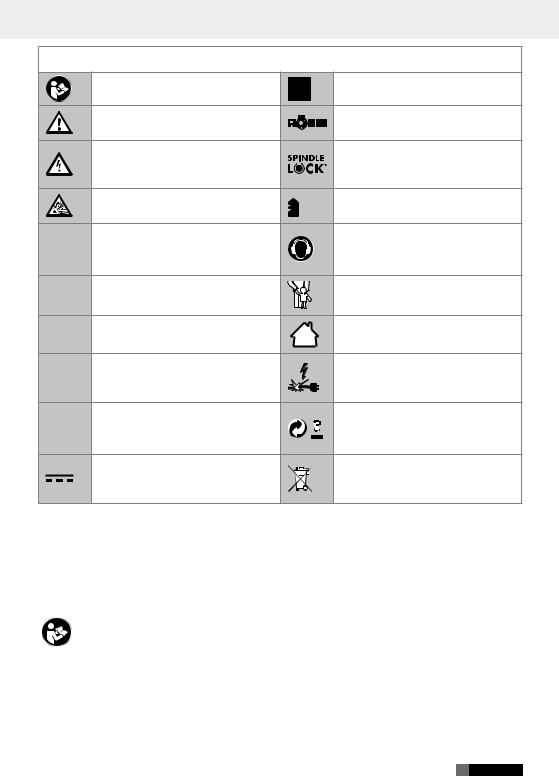
Wstęp
W niniejszej instrukcji obsługi urządzenia zastosowano następujące piktogramy:
|
Przeczytaj instrukcję obsługi! |
Klasa bezpieczeństwa II |
|
Przestrzegaj wskazówek |
Uchwyt wiertarski ‘Made in |
|
ostrzegawczych i bezpieczeństwa! |
Germany’ |
|
Ostrzeżenie przed porażeniem |
|
|
prądem elektrycznym! Zagrożenie |
Blokada wrzeciona |
|
dla życia! |
|
|
Niebezpieczeństwo wybuchu! |
Stopień wiertarski |
|
(dobór momentu obrotowego) |
|
|
|
|
W |
Watt (Moc skuteczna) |
Nosić ochronniki słuchu. |
|
||
n0 |
Wymiarowa liczba obrotów |
Dzieci trzymać z daleka od |
biegu luzem |
narzędzia elektrycznego! |
|
V~ |
Volt (Napięcie przemienne) |
Tylko do użytku w pomieszczeniach |
wewnętrznych! |
||
Ah |
|
Zwracać uwagę na nienaruszony |
ampero (Pojemność akumulatora) |
stan urządzenia, kabla sieciowego |
|
|
|
oraz wtyczki sieciowej! |
Nm |
|
Opakowanie i urządzenie przekaż |
Niutonometr (moment obrotowy) |
do utylizacji zgodnie z przepisami o |
|
|
|
ochronie środowiska! |
|
|
Nie wyrzucać akumulatorów do |
|
Prąd stały (rodzaj prądu i napięcia) |
odpadów i śmieci z gospodarstw |
|
|
domowych. |
Wiertarko-wkrętarka
Akumulatorowa PABS 18-Li B2
zania produktu innej osobie należy dołączyć do niego całą jego dokumentację.
|
|
Q Wstęp |
|
Q Przeznaczenie |
||
|
|
|
|
Gratulujemy zakupu nowego urządzenia. |
To urządzenie jest przeznaczone do wiercenia i |
|
|
|
|
|
|||
|
|
|
|
Tym samym zdecydowali się Państwo na |
wkręcania w drewno, plastik i metal. Urządzenie |
|
|
|
|
|
zakup produktu wysokiej jakości. Instrukcja |
należy stosować zgodnie z opisem i w podanych |
|
|
|
obsługi jest częścią tego produktu. Zawiera ona |
zakresach użytkowania. Jakiekolwiek inne użycie |
|||
|
|
ważne wskazówki dotyczące bezpieczeństwa, |
lub zmiany urządzenia uważane są za niezgodne |
|||
|
|
użytkowania i utylizacji. Przed pierwszym użyciem |
z przeznaczeniem i kryją w sobie poważne nie- |
|||
|
|
produktu należy zapoznać się ze wszystkimi wska- |
bezpieczeństwo wypadku. Producent nie bierze |
|||
|
|
zówkami dotyczącymi obsługi i bezpieczeństwa. |
na siebie żadnej odpowiedzialności w przypadku |
|||
|
|
Używać produktu wyłącznie zgodnie z jego poniżej |
powstania szkody, wynikającej z użytkowania |
|||
|
|
opisanym przeznaczeniem. W przypadku przeka- |
urządzenia w sposób całkowicie niezgodny z |
|||
|
|
|
|
|
|
|
|
18 |
PL |
|
|||
|
|
|
|
|
|
|

Wstęp
przeznaczeniem. Urządzenie nie nadaje się do celów komercyjnych.
Q Wyposażenie
1Przełącznik zmiany biegu
2Przełącznik kierunku obrotów
3WŁĄCZNIK / WYŁĄCZNIK / Regulacja prędkości obrotowej
4Uchwyt na bity
5Mocowanie paska
6Pakiet akumulatorów
7Przycisk do zwalniania blokady pakietu akumulatorów
8Przycisk lampki LED
9Lampka LED
10Lampka LED informująca o stanie naładowania akumulatorów
11Przycisk stanu naładowania akumulatorów
12Robocza lampka LED
13Uchwyt wiertarski 


14Nastawienie momentu obrotowego
15Ładowarka
16Czerwona dioda kontrolna
17Zielona dioda kontrolna
Q Zakres dostawy
1 Wiertarko-wkrętarka akumulatorowa z pakietem akumulatorόw
1 Bit PH2 50 mm
1 Ładowarka
1 Walizka do transportu i przechowywania
1 Instrukcja obsługi
Q Dane techniczne
PABS 18-Li B2 Wiertarko-wkrętarka
Akumulatorowa:
Napięcie znamionowe: |
18 V |
|
|
|
|||
Liczba obrotόw biegu |
|
|
|
jałowego: |
1. bieg: maks. 400 min-1 |
||
Liczba obrotόw biegu |
|
|
|
jałowego: |
2. bieg: maks. 1400 min-1 |
||
Zakres naprężenia |
|
|
|
uchwytu wiertarki: |
maks. 10 mm |
||
Maksymalny |
|
|
|
przekrόj odwiertu: |
stal: 10 mm, |
||
|
drewno: 30 mm |
||
Maks. moment obrotowy: |
35 Nm |
||
PABS 18-Li B2-1 Akumulator: |
|||
Typ: |
LITOWOJONOWY |
||
Napięcie nominalne: |
18 V |
|
|
|
|||
Pojemność: |
1,5 Ah |
||
Zawartość energetyczna: |
27 Wh |
||
PABS 18-Li B2-2 Ładowarka: |
|||
WEJŚCIE / Input: |
|
|
|
Napięcie nominalne: |
230 V , 50 Hz |
||
Pobór mocy: |
55 W |
||
WYJŚCIE / Output: |
|
|
|
Napięcie nominalne: |
18 V |
|
|
|
|||
Prąd ładowania: |
2 A |
||
Czas ładowania: |
ok. 60 min |
||
Klasa ochrony: |
II / |
||
Informacje dotyczące hałasu i wibracji:
Wartość pomiarowa hałasu wyznaczona zgodnie z EN 60745. Poziom hałasu elektronarzędzia wg oceny A wynosi typowo:
Poziom ciśnienia hałasu: 76 dB(A) Pozom mocy hałasu: 87 dB(A) Niepewność pomiaru K: 3 dB
Sumaryczne wartości drgań (suma wektorów z trzech kierunków) wyznaczone zgodnie z EN 60745:
Wkręcanie śrub: |
Wartość emisji drgań |
|
ah,D = 0,865 m / s2, |
|
Niepewność K = 1,5 m / s2, |
Wiercenie: |
Wartość emisji drgań |
|
ah = 2,546 m / s2, |
|
Niepewność K = 1,5 m / s2. |

 Podany w niniejszych instrukcjach poziom drgań wyznaczony został za pomocą metody pomiarowej określonej w normie EN 60745 i może zostać użyty do porównania urządzeń. Podany poziom emisji drgań może być wykorzystywany również do wstępnego oszacowania przerw w działaniu.
Podany w niniejszych instrukcjach poziom drgań wyznaczony został za pomocą metody pomiarowej określonej w normie EN 60745 i może zostać użyty do porównania urządzeń. Podany poziom emisji drgań może być wykorzystywany również do wstępnego oszacowania przerw w działaniu.
PL 19
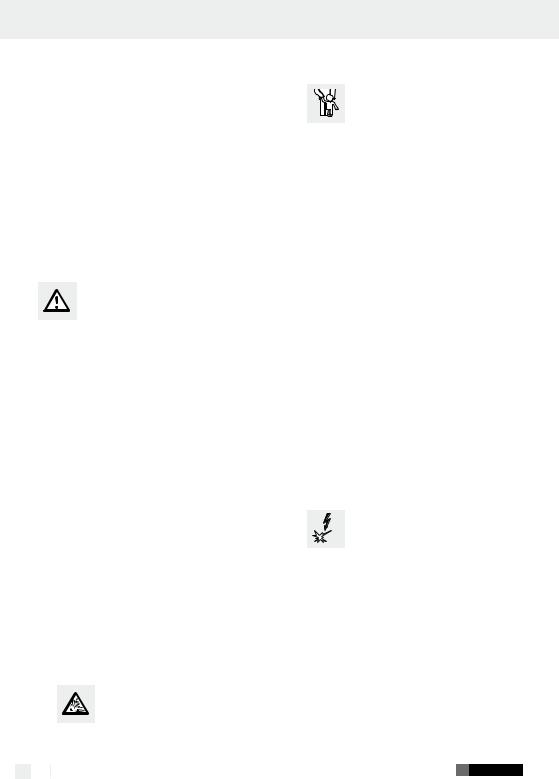
Wstęp / Ogólne wskazówki bezpieczeństwa dla elektronarzędzi
Poziom drgań będzie się różnił w zależności od zastosowania elektronarzędzia i w niektórych przypadkach może przekroczyć wartość podaną w niniejszej instrukcji. Obciążenie drganiami może wydawać się mniejsze niż w rzeczywistości, jeśli elektronarzędzie będzie regularnie używane ten sposób.
Wskazówka: Celem dokładnego oszacowania obciążenia wibracjami w okresie określonego okresu czasu pracy należy uwzględnić również te okresy, w których urządzenie jest wyłączone lub wprawdzie jest włączone, ale w rzeczywistości nie pracuje.
Może to przyczynić się do znacznej redukcji obciążenia wibracjami w całym okresie czasu pracy.
Ogólne wskazówki bezpie- czeństwa dla elektronarzędzi

 Przeczytaj wszystkie wskazówki dotyczące bezpieczeństwa oraz instrukcje! Zaniedbania w przestrzeganiu wskazówek dotyczących bezpieczeństwa oraz w przestrzeganiu instrukcji mogą spowodować porażenie prądem elektrycznym, pożar i / lub ciężkie obrażenia ciała.
Przeczytaj wszystkie wskazówki dotyczące bezpieczeństwa oraz instrukcje! Zaniedbania w przestrzeganiu wskazówek dotyczących bezpieczeństwa oraz w przestrzeganiu instrukcji mogą spowodować porażenie prądem elektrycznym, pożar i / lub ciężkie obrażenia ciała.
Przechowuj na przyszłość wszystkie wskazówki dotyczące bezpieczeństwa oraz instrukcje!
Używany we wskazówkach dotyczących bezpieczeństwa termin „narzędzie elektryczne“ odnosi się do narzędzi elektrycznych zasilanych z sieci (z kablem sieciowym) oraz do narzędzi elektrycznych zasilanych z akumulatorów (bez kabla sieciowego).
1. Bezpieczeństwo miejsca pracy
a)Utrzymywać stanowisko pracy w czystości i dobrze oświetlone. Nieporządek i nieoświetlone obszary robocze mogą prowadzić do wypadków.
elektryczne wytwarzają iskry, które mogą zapalić pył lub pary.
c)Podczas użytkowania urzą-
dzenia elektrycznego trzymaj dzieci i inne osoby z daleka
od urządzenia. Przy odchyleniu możesz stracić kontrolę nad urządzeniem.
2. Bezpieczeństwo elektryczne
a)Wtyk sieciowy urządzenia musi pasować do wtykowego gniazdka sieciowego. W żaden sposób nie wolno zmieniać wtyku sieciowego urządzenia. Nie używaj żadnych wtyków adapterowych razem z urządzeniami wyposażonymi w uziemienie ochronne.
Niezmienione wtyki sieciowe i pasujące wtykowe gniazdka sieciowe zmniejszają ryzyko porażenia prądem elektrycznym.
b)Unikaj kontaktu fizycznego z powier zchniami uziemionymi takimi jak powierzchnie rur, grzejników, kuchni elektrycznych i lodówek. Istnieje podwyższone niebezpieczeństwo porażenia prądem elektrycznym, gdy twoje ciało jest uziemione.
c)Trzymaj urządzenie z daleka od deszczu i wilgoci. Wniknięcie wody do urządzenia elektrycznego zwiększa ryzyko porażenia prądem elektrycznym.
d)Nie używaj kabla sieciowego w
sposób sprzeczny z jego prze- 
 znaczeniem, tj. do noszenia urządzenia, zawieszania urzą dzenie lub do wyciągania wtyku sieciowego z wtykowego gniazdka sieciowego. Trzymaj kabel z daleka od gorąca, oleju, ostrych krawędzi lub poruszających się części urządzeń. Uszkodzone lub poplątane kable zwiększają ryzyko porażenia prądem elektrycznym.
znaczeniem, tj. do noszenia urządzenia, zawieszania urzą dzenie lub do wyciągania wtyku sieciowego z wtykowego gniazdka sieciowego. Trzymaj kabel z daleka od gorąca, oleju, ostrych krawędzi lub poruszających się części urządzeń. Uszkodzone lub poplątane kable zwiększają ryzyko porażenia prądem elektrycznym.
e) Gdy pracujesz z urządzeniem elektrycz-
b)Nie pracuj przy użyciu urządzenym na dworze używaj wyłącznie prze-
nia w otoczeniu zagrożonym |
dłużaczy, które są dopuszczone również |
eksplozją, w którym znajdują |
do pracy na dworze. Użycie przedłużacza |
się palne ciecze, gazy lub pyły. Urządzenia |
przystosowanego do stosowania na dworze zmniej- |
|
sza ryzyko porażenia prądem elektrycznym. |
20 PL

Ogólne wskazówki bezpieczeństwa dla elektronarzędzi
f)Jeśli praca elektronarzędzia w otoczeniu wilgotnym jest nie do uniknięcia, należy zastosować wyłącznik prądu uszkodzeniowego. Zastosowanie wyłącznika prądu uszkodzeniowego zapobiega niebezpieczeństwu porażenia prądem elektrycznym.
3. Bezpieczeństwo osób
a)Bądź stale uważny, zwracaj uwagę na to co robisz i postępuj rozsądnie w trakcie pracy z narzędziem elektrycznym. Nie używaj narzędzia, gdy jesteś zmęczony lub znajdujesz się pod wpływem narkotyków, alkoholu lub lekarstw. Chwila nieuwagi przy użytkowaniu urządzenia może prowadzić do poważnych obrażeń ciała.
b)Noś osobiste wyposażenie ochronne i zawsze okulary ochronne. Noszenie osobistego wyposażenia ochronnego takiego jak maska przeciwpyłowa, buty antypoślizgowe, kask ochronny lub ochrona słuchu stosownie do sposobu użytkowania narzędzia elektrycznego zmniejsza ryzyko obrażeń ciała.
c)Unikaj niezamierzonego uruchomienia. Upewnij się, że narzędzie elektryczne jest wyłączone zanim podłączysz je do zasilania prądowego, uchwycisz je lub będziesz je przenosił. Jeżeli podczas przenoszenia urządzenia będziesz trzymał palec na przełączniku WŁĄCZ. / WYŁĄCZ. lub jeżeli urządzenie jest włączone, to może to prowadzić do nieszczęśliwych wypadków.
d)Usuń narzędzia do nastawiania urządzenia lub klucze płaskie zanim włączysz urządzenie. Narzędzie lub klucz, który znajduje się w obracającej się części urządzenia może prowadzić do obrażeń ciała.
e)Unikaj nienormalnej postawy ciała. Zadbaj o pewne stanowisko i w każdej chwili utrzymuj równowagę. Dzięki temu będziesz mógł lepiej kontrolować urządzenie, zwłaszcza w nieoczekiwanych sytuacjach.
f)Noś odpowiednią odzież. Nie noś obszernej odzieży ani biżuterii. Trzymaj włosy, odzież i rękawice z daleka od
poruszających się części. Luźna odzież, biżuteria lub długie włosy mogą zostać uchwycone przez poruszające się części.
g)Jeżeli zostaną zamontowane urządzenia do odsysania i wychwytywania pyłu, to upewnij się, że są one podłączone i że będą prawidłowo używane.
Używanie tych urządzeń zmniejsza zagrożenie wywoływane pyłem.
4.Staranne obchodzenie
się i użytkowanie narzędzi elektrycznych
a)Nie przeciążaj urządzenia. Używaj do swojej pracy przeznaczonego do niej narzędzia elektrycznego. Za pomocą odpo wiedniego narzędzia elektrycznego pracujesz lepiej i bezpieczniej w danym zakresie robót.
b)Nie używaj żadnego narzędzia elektrycznego, którego przełącznik jest uszkodzony. Narzędzie elektryczne, które nie daje się już więcej włączyć lub wyłączyć, jest niebezpieczne i musi zostać naprawione.
c)Proszę usunąć wtyczkę z gniazdka oraz / lub usunąć akumulator, zanim rozpoczną państwo ustawienie urządzenia, wymianę części lub w przypadku odłożenia urządzenia. Niniejsze przedsięwzięcie zapobiega niekontrolowanemu rozruchowi niniejszego narzędzia elektrycznego.
d)Przechowuj nieużywane narzędzia elektryczne poza zasięgiem dzieci. Nie pozwól na użytkowanie urządzenia osobom, które nie są z nim obznajomione lub nie przeczytały niniejszych instrukcji. Narzędzia elektryczne są niebezpieczne, gdy są używane przez osoby niedoświadczone.
e)Pielęgnuj starannie urządzenie. Sprawdź, czy ruchome części urządzenia funkcjonują nienagannie i nie zakleszczają się, czy części urządzenia nie są złamane lub uszkodzone w takim stopniu, że funkcjonowanie urządzenia jest uszczuplone. Zleć naprawę uszkodzonych części przed użyciem
PL 21

Ogólne wskazówki bezpieczeństwa dla elektronarzędzi
urządzenia. Przyczyną wielu wypadków są źle konserwowane narzędzia elektryczne.
f)Utrzymuj narzędzia tnące w stanie ostrym i czystym. Starannie pielęgnowane narzędzia tnące o ostrych krawędziach tnących mniej zakleszczają się i dają się łatwiej prowadzić.
g)Używaj narzędzia elektrycznego, osprzętu, narzędzi wymiennych itp. odpowiednio do niniejszych instrukcji i w taki sposób, jaki jest zalecany dla tego specjalnego typu urządzenia.
Uwzględniaj przy tym warunki robocze i wykonywane czynności. Użycie narzędzi elektrycznych do innych zastosowań niż to przewidziano może prowadzić do niebezpiecznych sytuacji.
z pomocy lekarskiej. Wyciekła ciecz akumulatorowa może prowadzić do podrażnień skóry lub oparzeń.
OSTROŻNIE! ZAGROŻENIE EKSPLOZJĄ! Nie należy ładować baterii nie przystosowanych do
powtόrnego ładowania.
6. Serwis
a)Urządzenie oddawać do naprawy tylko wykwalifikowanemu personelowi fachowemu i tylko z użyciem oryginalnych części zamiennych. To sposób na zapewnienie bezpieczeństwa urządzenia.
5.Używanie i obchodzenie się z narzędziem akumulatorowym
a)Ładuj akumulatory wyłącznie w tych ładowarkach, które są zalecane przez producenta. Dla ładowarki, która nadaje się do określonego rodzaju akumulatorów istnieje zagrożenie pożarowe, gdy będzie ona używana z innymi akumulatorami.
b)W narzędziach elektrycznych stosuj wyłącznie przewidziane dla nich akumulatory. Używanie innych akumulatorów może prowadzić do obrażeń ciała i zagrożenia pożarowego.
c)Nieużywane akumulatory trzymaj z daleka od spinaczy biurowych, monet, kluczy, gwoździ śrub oraz innych małych przedmiotów metalowych, które mogłyby spowodować zmostkowanie styków akumulatora. Skutkiem zawarcia styków akumulatora mogą być oparzenia lub pożar.
d)W przypadku nieprawidłowego zastosowania akumulatora może z niego wyciec ciecz. Unikaj kontaktu z nią. W razie przypadkowego kontaktu spłucz ją wodą. Jeżeli ta ciecz dostanie się do oka, to dodatkowo skorzystaj
22 PL
Wskazówki dotyczące bezpieczeństwa dla wiertarkowkrętarek akumulatorowych

 Podczas wykonywania prac, przy których śruba może trafić na ukryte przewody energetyczne lub na własny kabel sieciowy, trzymać urządzenie za izolowane uchwyty.
Podczas wykonywania prac, przy których śruba może trafić na ukryte przewody energetyczne lub na własny kabel sieciowy, trzymać urządzenie za izolowane uchwyty.
Kontakt śruby z przewodem znajdującym się pod napięciem może spowodować, że także metalowe części urządzenia znajdą się pod napięciem, i w konsekwencji doprowadzić do porażenia elektrycznego.
Dzieciom lub osobom, którym brak wiedzy lub doświadczenia w obchodzeniu się z urządzeniem oraz osobom, które są ograniczone pod względem ich fizycznych, sensorycznych lub duchownych zdolności, nie wolno obsługiwać urządzenia bez nadzoru lub wskazówek osoby odpowiedzialnej za ich bezpieczeństwo. Dzieci muszą być nadzorowane, aby nie bawiły się urządzeniem.
Zabezpiecz przedmiot obrabiany. Przedmiot obrabiany przytrzymywany za pomocą urządzenia mocującego lub imadła jest trzymany pewniej niż ręką.

 TRUJĄCE PYŁY!
TRUJĄCE PYŁY!
Powstające wskutek obróbki szkodliwe / trujące
